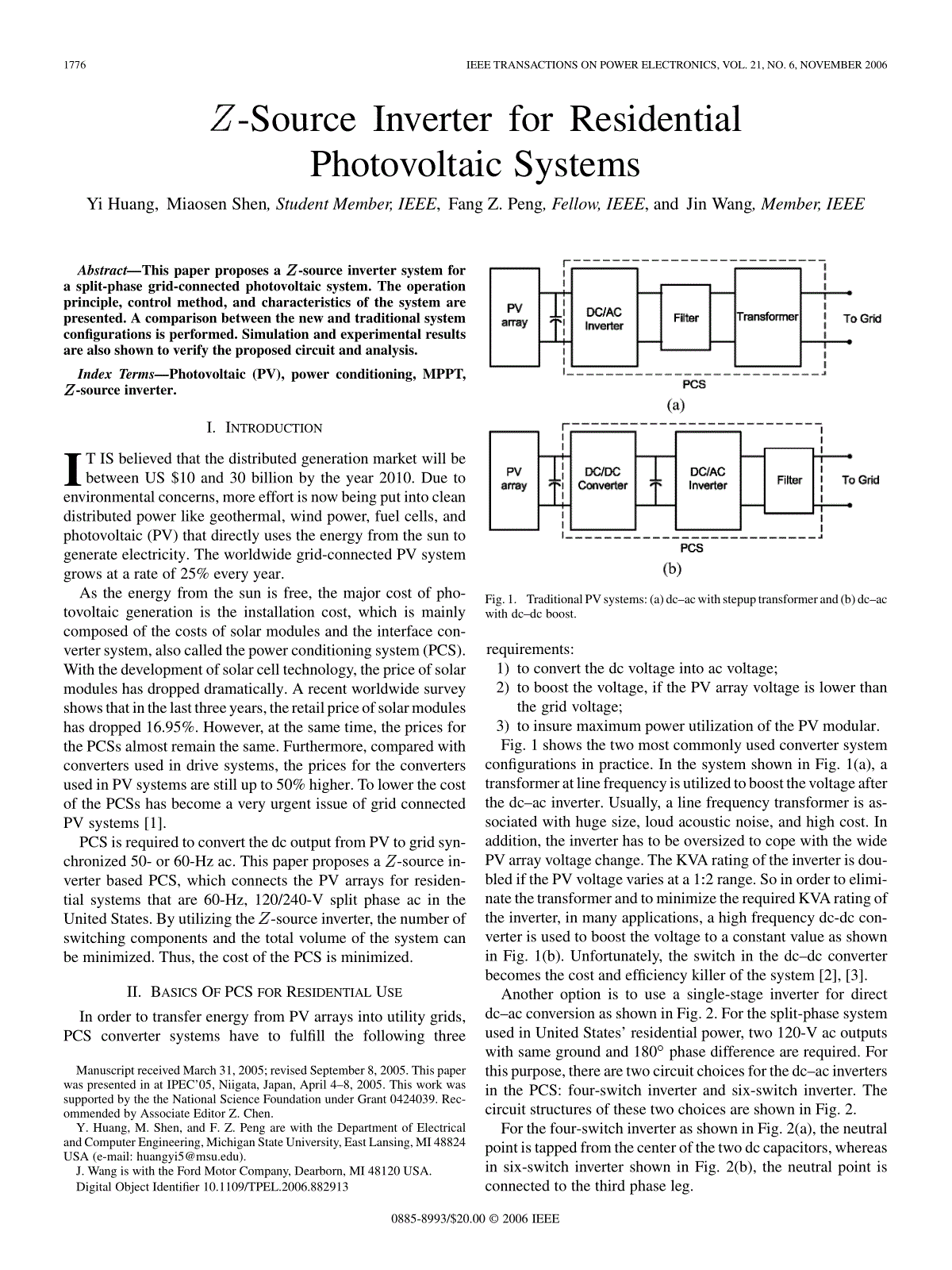1776IEEETRANSACTIONSONPOWERELECTRONICS,VOL.21,NO.6,NOVEMBER2006Z-SourceInverterforResidentialPhotovoltaicSystemsYiHuang,MiaosenShen,StudentMember,IEEE,FangZ.Peng,Fellow,IEEE,andJinWang,Member,IEEEAbstract—Thispaperproposesa-sourceinvertersystemforasplit-phasegrid-connectedphotovoltaicsystem.Theoperationprinciple,controlmethod,andcharacteristicsofthesystemarepresented.Acomparisonbetweenthenewandtraditionalsystemconfigurationsisperformed.Simulationandexperimentalresultsarealsoshowntoverifytheproposedcircuitandanalysis.IndexTerms—Photovoltaic(PV),powerconditioning,MPPT,-sourceinverter.I.INTRODUCTIONITISbelievedthatthedistributedgenerationmarketwillbebetweenUS$10and30billionbytheyear2010.Duetoenvironmentalconcerns,moreeffortisnowbeingputintocleandistributedpowerlikegeothermal,windpower,fuelcells,andphotovoltaic(PV)thatdirectlyusestheenergyfromthesuntogenerateelectricity.Theworldwidegrid-connectedPVsystemgrowsatarateof25%everyyear.Astheenergyfromthesunisfree,themajorcostofpho-tovoltaicgenerationistheinstallationcost,whichismainlycomposedofthecostsofsolarmodulesandtheinterfacecon-vertersystem,alsocalledthepowerconditioningsystem(PCS).Withthedevelopmentofsolarcelltechnology,thepriceofsolarmoduleshasdroppeddramatically.Arecentworldwidesurveyshowsthatinthelastthreeyears,theretailpriceofsolarmoduleshasdropped16.95%.However,atthesametime,thepricesforthePCSsalmostremainthesame.Furthermore,comparedwithconvertersusedindrivesystems,thepricesfortheconvertersusedinPVsystemsarestillupto50%higher.TolowerthecostofthePCSshasbecomeaveryurgentissueofgridconnectedPVsystems[1].PCSisrequiredtoconvertthedcoutputfromPVtogridsyn-chronized50-or60-Hzac.Thispaperproposesa-sourcein-verterbasedPCS,whichconnectsthePVarraysforresiden-tialsystemsthatare60-Hz,120/240-VsplitphaseacintheUnitedStates.Byutilizingthe-sourceinverter,thenumberofswitchingcomponentsandthetotalvolumeofthesystemcanbeminimized.Thus,thecostofthePCSisminimized.II.BASICSOFPCSFORRESIDENTIALUSEInordertotransferenergyfromPVarraysintoutilitygrids,PCSconvertersystemshavetofulfillthefollowingthreeManuscriptreceivedMarch31,2005;revisedSeptember8,2005.ThispaperwaspresentedinatIPEC’05,Niigata,Japan,April4–8,2005.ThisworkwassupportedbythetheNationalScienceFoundationunderGrant0424039.Rec-ommendedbyAssociateEditorZ.Chen.Y.Huang,M.Shen,andF.Z.PengarewiththeDepartmentofElectricalandComputerEngineering,MichiganStateUniversity,EastLansing,MI48824USA(e-mail:huangyi5@msu.edu).J.WangiswiththeFordMotorCompany,Dearborn,MI48120USA.DigitalObjectIdentifier10.1109/TPEL.2006.882913Fig.1.TraditionalPVsystems:(a)dc–acwithstepuptransformerand(b)dc–acwithdc–dcboost.requirements:1)toconvertthedcvoltageintoacvoltage;2)toboostthevoltage,ifthePVarrayvoltageislowerthanthegridvoltage;3)toinsuremaximumpowerutilizationofthePVmodular.Fig.1showsthetwomostcommonlyusedconvertersystemconfigurationsinpractice.InthesystemshowninFig.1(a),atransformeratlinefrequencyisutilizedtoboostthevoltageafterthedc–acinverter.Usually,alinefrequencytransformerisas-sociatedwithhugesize,loudacousticnoise,andhighcost.Inaddition,theinverterhastobeoversizedtocopewiththewidePVarrayvoltagechange.TheKVAratingoftheinverterisdou-bledifthePVvoltagevariesata12range.Soinordertoelimi-natethetransformerandtominimizetherequiredKVAratingoftheinverter,inmanyapplications,ahighfrequencydc-dccon-verterisusedtoboostthevoltagetoaconstantvalueasshowninFig.1(b).Unfortunately,theswitchinthedc–dcconverterbecomesthecostandefficiencykillerofthesystem[2],[3].Anotheroptionistouseasingle-stageinverterfordirectdc–acconversionasshowninFig.2.Forthesplit-phasesystemusedinUnitedStates’residentialpower,two120-Vacoutputswithsamegroundand180phasedifferencearerequired.Forthispurpose,therearetwocircuitchoicesforthedc–acinvertersinthePCS:four-switchinverterandsix-switchinverter.ThecircuitstructuresofthesetwochoicesareshowninFig.2.Forthefour-switchinverterasshowninFig.2(a),theneutralpointistappedfromthecenterofthetwodccapacitors,whereasinsix-switchinvertershowninFig.2(b),theneutralpointisconnectedtothethirdphaseleg.0885-8993/$20.00©2006IEEEHUANGetal.:-SOURCEINVERTER1777Fig.2.DirectPVinvertersystemsfor120-Vsplitphaseresidentialpower.(a)Fourswitchinverter.(b)Sixswitchinverter.Thetwophaselegsinthefour-switchinverterarecontrolledbysynchronizedpulsewidthmodulation(SPWM).Twosinusoidalcontrolreferenceswitha180phasedifferenceandthesameamplitudeareutilizedtocomparewithatriangularcarrier.Thebasiccontrolschemeofthesix-switchinverterisshowninFig.3.Twoofthephaselegs,“b”and“c,”havetheexactsameSPWMcontrolasinfour-switchinverter.Thethirdphaseleg,“a,”isusuallycontrolledtoproduceasquarewaveformwith50%dutyratioatthecarrierfrequencytoserveastheneutralphaseandatthesametimeachievethemaximumutilizationofthedcbusvoltage.Theswitchingfrequencyofthethirdlegcanbedifferentfromtheothertwophaselegs.Bypropercoordinatingthecontroloftheneutralphaselegandtheothertwophaselegs,theequivalentswitchingfrequencycanbedoubled,thustheoutputfiltercanbeoptimized.Itisgenerallybelievedthatthesix-switchinverterhasbetterperformancet





 三七文档所有资源均是用户自行上传分享,仅供网友学习交流,未经上传用户书面授权,请勿作他用。
三七文档所有资源均是用户自行上传分享,仅供网友学习交流,未经上传用户书面授权,请勿作他用。
本文标题:$Z$-Source Inverter for Residential Photovoltaic S
链接地址:https://www.777doc.com/doc-3246889 .html